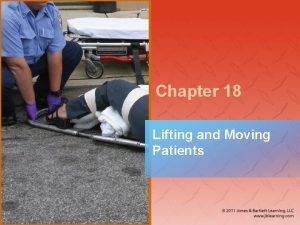Moving Victims General Principles Moving Victims n n






- Slides: 6

Moving Victims General Principles

Moving Victims n n n A victim should not be moved until he or she is ready for transportation to a hospital, if required. All necessary first aid should be provided before moving a victim. Do not move a victim unless you absolutely have to. That might happen if the victim is in immediate danger or must be moved to shelter while waiting for the EMS to arrive.

Examples of immediate danger There is fire or danger of fire. n Explosives or other hazardous materials are involved. n It is impossible to protect the accident scene from hazards. n It is impossible to gain access to other victims in the situation who need lifesaving care (such as in a motor vehicle accident). n

Other considerations n n n n Do not move a victim if so doing will make the injury worse. Do not move a victim who could have a spinal injury. Do not move a victim without stabilizing the injured part. Do not move a victim unless you know where you are going. Do not leave an unconscious victim alone unless taking a short time to call EMS. Do not move a victim when you can send someone for help. Wait with the victim. Do not try to move a victim by yourself if other people are available to help.

If you need to move a victim: n n n Know your capabilities. Do not try to handle a load that is too heavy or awkward – seek help. Use a safe grip. Use as much of your palms as possible. Keep your back straight. Tighten the muscles of your buttocks and abdomen. Bend your knees to use the strong muscles of the thighs and buttocks. Lift with your legs. Keep your arms close to your body and your elbows flexed.

n n n Position your feet shoulder-width apart for balance, one in front of the other. When lifting, keep and lift the victim close to your body. Keep victim’s body straight. While lifting, do not twist your back; pivot with the feet. Lift and carry slowly, smoothly, and in unison with other helpers. Before you move a victim, tell him or her what you are doing.











